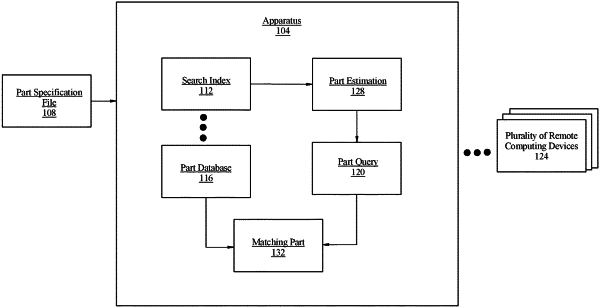| CPC G06F 16/148 (2019.01) [G06F 16/13 (2019.01); G06F 16/144 (2019.01); G06F 16/156 (2019.01); G06N 20/00 (2019.01)] | 20 Claims |

|
1. An apparatus for geometric part searching, comprising:
at least a processor and a memory communicatively connected to the at least a processor, the memory containing instructions configuring the at least a processor to:
receive a plurality of part specification files, wherein each part specification file of the plurality of part specification files comprises at least a geometric feature;
determine a scalar variable of the at least a geometric feature of each part specification file of the plurality of part specification files;
generate a search index as a function of the plurality of part specification files, wherein the search index is configured to map, as a function of the scalar variable, at least a part specification file of the plurality of part specification files to another part specification file in a part specification file database, wherein the search index is further configured to utilize a part matching machine learning model, wherein utilizing the part matching machine learning model comprises:
training a part matching machine learning model using part training data wherein part training data correlates inputs containing part datum elements to outputs containing matching parts, wherein training the part matching machine learning model comprises:
updating the part training data as a function of an input and output result from the part matching machine learning model; and
retraining the part matching machine learning model with the updated part training data;
receive an input part specification file, wherein the input part specification file comprises a plurality of geometric features;
generate a query for an input part as a function of the input part specification file and the search index, wherein the query is configured to:
match a dimensional element of the input part specification file to a dimensional element of part estimation specification file of the search index as a function of a dimensional element threshold; and
output a comparison of the input part specification file to the part estimation specification file of the search index as a function of the matching of the dimensional element of the input part specification file to the part estimation specification file, wherein the comparison of the input part specification file to the part estimation specification file comprises:
a mechanical compatibility comparison to determine a likeliness of a structural connection between the dimensional element of the input part specification file and the dimensional element of the part estimation specification file;
a fit criteria comparison, wherein the fit criteria comprises a set of geometric prerequisites needed for an object to connect another object;
a part functionality comparison wherein the part functionality comparison comprises:
vibrational qualities, including at least resonant frequency;
a rotationality, wherein the rotationality includes an ability of the part to rotate about an axis; and
a flexibility; and
a geometric feature comparison;
generate an objective function comprising a minimizing loss function further comprising minimization of at least fit criteria differences;
identify a matching part estimation specification file from a plurality of query results generated from the query;
output the matching part based on the objective function and the comparison of the input part specification file to the part estimation specification file; and
receive an authorization from a user for the matching part.
|